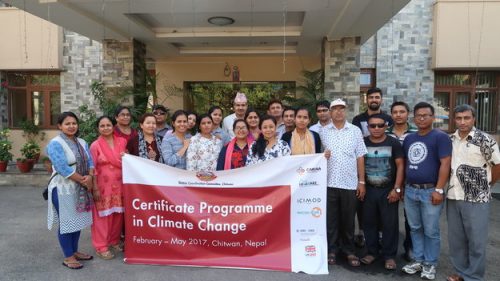by Debabrat Sukla and Mandira Shrestha

Other than being catalogued and bound into thick journals to gather dust, what is the use of high-level climate change research? The hours of painstaking literature review, controlled experiments and field observations, must count for something, right? The critique, generally, is that the climate change information being produced at the moment is very technical. This technicality hinders the potential for interaction with a wide audience group. Putting research to use serves as an important benchmark in discerning not just success, but also the applicability of a given research.
Building from a consultation held in February 2016, the Himalayan Adaptation Water and Resilience (HI-AWARE) Research recognized the value of engaging with stakeholders across the local level in Nepal, using the format of a certificate course. Banking on the value of this interaction, HI-AWARE also realized that stakeholders in its study areas were interested in the research being generated. But infographics and posters on our research weren’t quite cutting it. We needed a platform, which brought user-inspired climate science into focus, that is, a combination of research conducted from the initiative, and stakeholder inputs from the grassroots. Thus the Certificate Programme in Climate Change (CPCC) was designed for local government officials consisting of four modules running from February through June 2017. With technical support from the International Centre for Integrated Mountain Development (ICIMOD) and Practical Action, the programme was organized by the District Coordination Committee, Chitwan.
Each module of the programme consists of different topics related to climate change and its interlinkages to various socio-political issues. The first module focused on the basics of climate change, climate variability, and temporal and spatial difference, and was covered in an event held in February 2017. The second module focused on climate associated hazards, and covered in an event held in March 2017. The third and fourth modules on climate change adaptation and gender dimensions respectively were covered in a joint event held in Bharatpur, Chitwan from 29 May to 2 June 2017. Based on previous classes, the learning approach for this module focused on learner-centered methods and interactive practical work. Aimed at a user group that regularly came across climate related issues in its line of work, the course sought to instill a sense of connectedness among its users.
 During the in-house training session on gender, participants were asked to use cue-cards to differentiate between social and biological factors that contribute to an individual.
During the in-house training session on gender, participants were asked to use cue-cards to differentiate between social and biological factors that contribute to an individual.
Practitioners were strongly encouraged to understand that present day issues each have their own historicity and context. Set in this, it becomes impossible to see a particular problem in isolation. For example, it is necessary to know the local context when mapping the vulnerability of communities. A day’s field visit to the villages of Bote Tole and Gaidi were important exercises for not just the participants, but also the resource persons. Taking this a step further, an in-house workshop on gendered vulnerabilities asked very poignant questions about societal trends and gendered norms prevalent in Nepali society. Judging the length of someone’s hair may not be a good indicator, but differentiating between societal preferences in the length of hair, type of clothes, and the division of tasks is crucial.

 Participants interacting with the community at the Bote Tol village where issues of flooding and river embankment were discussed. The river that lies adjacent to the village is locally known as the ‘mad river’, because of the damages the community used to face prior to the embankment being setup.
Participants interacting with the community at the Bote Tol village where issues of flooding and river embankment were discussed. The river that lies adjacent to the village is locally known as the ‘mad river’, because of the damages the community used to face prior to the embankment being setup.
Another example was when participants were asked to visualize ideal communities versus those affected by climate change. There were beautiful drawings made on A3 chart paper of communities based on a foothill. Everything was perfect, with perfect trees, perfect houses, and smiling faces. On another sheet however, the same scene was drawn, but now with poached wildlife, landslides, and flood-affected tracts of land. The number of issues considered within one canvas was definitely heartening to see.
Drawing from the feedback received, many participants were not only aware of the differentiated levels of understanding within their peer group inside the class, but also in their workplace. Many expressed their desire to carry forward the information they had gained in terms of planning and execution in their respective work areas.
The culmination of this course, which started in February this year, points towards a way forward. Rampur Agricultural University, Bharatpur, Nepal, has shown considerable interest in incorporating this course into its curriculum. This course also holds promise for other regions in the Hindu Kush Himalayan context where institutions would be willing to take the possibilities of the classroom to practitioners.
*The Certificate Programme in Climate Change is a collaborative initiative supported by ICIMOD, Nepal; the District Coordination Committee, Chitwan; and Practical Action, Nepal.
